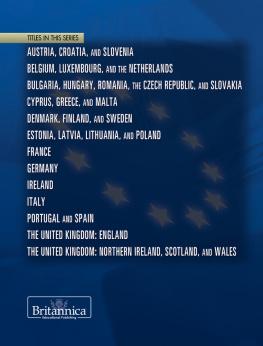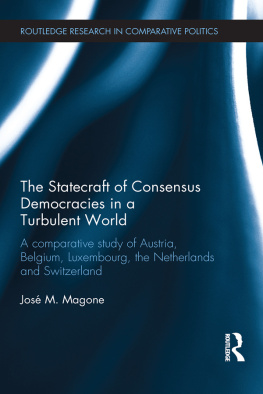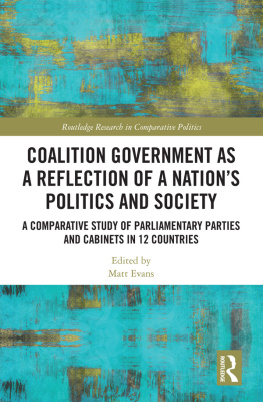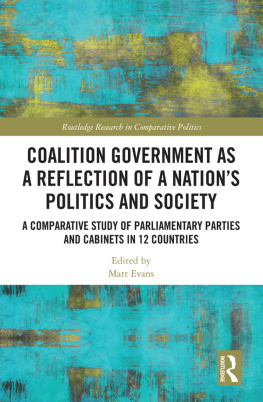High Politics in the Low Countries
For Yasemin
First published 2003 by Ashgate Publishing
Reissued 2018 by Routledge
2 Park Square, Milton Park, Abingdon, Oxon OX14 4RN
711 Third Avenue, New York, NY 10017, USA
Routledge is an imprint of the Taylor & Francis Group, an informa business
Copyright Arco I. Timmermans 2003
All rights reserved. No part of this book may be reprinted or reproduced or utilised in any form or by any electronic, mechanical, or other means, now known or hereafter invented, including photocopying and recording, or in any information storage or retrieval system, without permission in writing from the publishers.
Notice:
Product or corporate names may be trademarks or registered trademarks, and are used only for identification and explanation without intent to infringe.
Publishers Note
The publisher has gone to great lengths to ensure the quality of this reprint but points out that some imperfections in the original copies may be apparent.
Disclaimer
The publisher has made every effort to trace copyright holders and welcomes correspondence from those they have been unable to contact.
A Library of Congress record exists under LC control number: 2002190862
ISBN 13: 978-1-138-70987-4 (hbk)
ISBN 13: 978-1-315-19939-9 (ebk)
On 15 May 2002, the most dramatic parliamentary elections since 1945 took place in the Netherlands. A week before the elections, the charismatic leader of a new party, the Lijst Pirn Fortuyn, was assassinated. This party was as a protest party challenging the three party coalition that had governed the country for eight years. This coalition controlled 97 of the 150 seats in the Second Chamber, the lower house of parliament, but after election day only 54 seats were left. The Lijst Pirn Fortuyn, which was formed only a few months before the elections, took 26 seats and became the second largest party.
These elections shocked the established parties and marked the beginning of a government formation that would make things different. Promises were made about a change in the style of politics: less wheeling and dealing behind closed doors, and more openness. The formateurs party, the CDA (Christian Democrats), declared that the new coalition parties should make as few precommitments as possible the coalition agreement should be not longer than one page, cabinet ministers should have more autonomy than before, and parliament should be more critical and less constrained by the mores of coalition discipline.
When after two months of negotiations the new government composed of CDA, VVD (Liberals) and Lijst Pirn Fortuyn took office, it had a coalition agreement of 45 pages, but with many vague intentions to which only few ministers had contributed. The relatively short negotiations had been surrounded by secrecy even to candidates for a cabinet portfolio. Several newly appointed ministers expressed policy ambitions in contradiction to the coalition agreement, and this led to anxiety among the parliamentary leaders who had negotiated the deals. Moreover, the Lijst Pirn Fortuyn was barely a political party and became an arena of internal discord and leadership rivalry. This new coalition government led by a relatively unexperienced prime minister had invested in establishing policy agreement before taking office, but many doubts existed about the stability of this political fundament.
Coalition agreements between political parties taking office together are the central subject of this book. A large discrepancy exists between the broad attention for coalition agreements among political and social actors and in the media in countries with coalition governments, and the rather limited attention for this subject in the political science literature. This book explores the roles of coalition agreements in politics. Many of the ideas about this subject developed in discussions with Jean Blondel and Rudy B. Andeweg, at different locations of which the European University Institute in Florence has been most important to me. I would also like to thank the members of the research team on Actors and Institutions in Western European Parliamentary Democracies, who in one way or another helped to streamline my ideas about coalition politics. Peter Scholten has been a great research assistant during the final stage of this book project.
Finally, I would like to thank all of my friends for their support during my research. In particular, I remember my stay at Amasya in May 2002 thanks mm Glsm Cegerek-Matpan, your hospitality and warmth are invaluable to me. To your daughter, Yasemin Cegerek, my partner for life, I dedicate this book.
Enschede, August 2002
Chapter 1
Government Formation and Beyond: An Empirical Study
One of the most obvious questions someone could ask about coalition governments is what these governments do. Since coalitions began to be studied in the early 1960s, however, this question has hardly been addressed in a systematic way. Most of the time, attention in coalition research was focused on the formation of coalitions and on their end, and both were the subject of deductive theory building based on the assumptions of rational choice.
The most extensively studied element of coalition politics was government formation. Theories on this subject evolved from variations of Rikers straightforward size principle (1962) to sophisticated approaches dealing with bargaining strategies and the different kinds of results they may yield. The other challenge that drove theorists in the same intellectual comer was to explain the stability and duration of coalitions (see Warwick, 1994 and Laver and Shepsle, 1996 for useful discussions of this literature). There has been attention for aspects of the life of governments, but this has formed a research world apart, the domain of country specialists and comparativists going into entirely different questions not specific to coalition governments (see for example Blondel, 1988; Blondel and Mller-Rommel, 1993; Blondel and Cotta, 1996). The consequence of this remarkable research landscape is that the answers to the question what happens during the life of coalition governments still contain a good deal of speculation.
Linking Coalition Birth to Life: Coalition Agreements
Bargaining between parties is a key element of coalition government. Interparty bargaining never stops, and this is an intriguing point for students of coalition governments. As said, government formation often is taken as the focal point in studies of coalition bargaining. But if government formation is the point of departure in analysis, it need not also be the end point. Coalition agreements link government formation to government life. Parties all calculate their policy payoffs before government arrangements are definitive and ratified, but these payoffs concern intentions that begin to have a substantive meaning only after the government has taken office. Then, bargaining either may no longer be necessary because all policy disputes were settled, or bargaining may go on, and usually this is what happens.
From country reports we know that there is variation in the time and energy devoted to policy negotiations during government formation. This means, that coalition agreements, the written documents containing all kinds of intentions on coalition policy, may also vary between coalitions and between countries.
A minimum position with respect to the actual meaning of such coalition agreements is taken by Laver and Schofield in their book Multiparty Government (1990). They argue that interparty policy negotiations have a symbolic meaning, confirming the common viewpoints rather than that they are organized to establish agreement on policy conflicts. If parties want to form a coalition, they argue, why would they bother in advance about policy conflicts and constrain themselves by formulating all kinds of commitment? Luebbert (1986) asserts that policy negotiations during government formation have mainly intraparty purposes. Party leaders are seen to use these negotiations to keep their followers happy.











